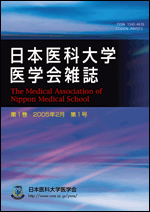12 巻, 3 号
選択された号の論文の10件中1~10を表示しています
- |<
- <
- 1
- >
- >|
橘桜だより
-
2016 年12 巻3 号 p. 75
発行日: 2016/06/15
公開日: 2016/07/13
PDF形式でダウンロード (299K)
グラビア
-
2016 年12 巻3 号 p. 76-77
発行日: 2016/06/15
公開日: 2016/07/13
PDF形式でダウンロード (639K)
綜説
-
2016 年12 巻3 号 p. 78-85
発行日: 2016/06/15
公開日: 2016/07/13
PDF形式でダウンロード (370K) -
2016 年12 巻3 号 p. 86-91
発行日: 2016/06/15
公開日: 2016/07/13
PDF形式でダウンロード (289K)
臨床医のために
-
2016 年12 巻3 号 p. 92-94
発行日: 2016/06/15
公開日: 2016/07/13
PDF形式でダウンロード (378K)
看護師シリーズ
-
2016 年12 巻3 号 p. 95-96
発行日: 2016/06/15
公開日: 2016/07/13
PDF形式でダウンロード (172K) -
2016 年12 巻3 号 p. 97-98
発行日: 2016/06/15
公開日: 2016/07/13
PDF形式でダウンロード (120K)
関連施設だより
-
2016 年12 巻3 号 p. 99-100
発行日: 2016/06/15
公開日: 2016/07/13
PDF形式でダウンロード (273K)
JNMSのページ
-
2016 年12 巻3 号 p. 101-103
発行日: 2016/06/15
公開日: 2016/07/13
PDF形式でダウンロード (264K)
集会記事
-
2016 年12 巻3 号 p. 104-111
発行日: 2016/06/15
公開日: 2016/07/13
PDF形式でダウンロード (432K)
- |<
- <
- 1
- >
- >|
